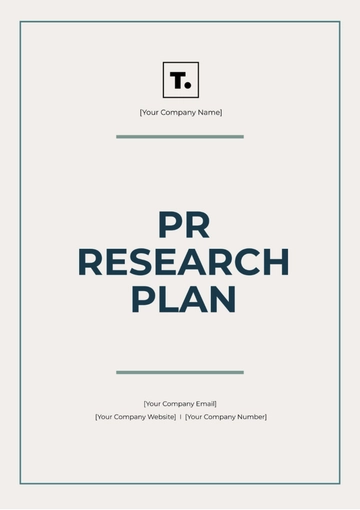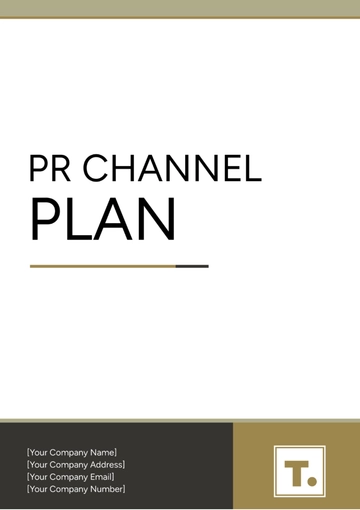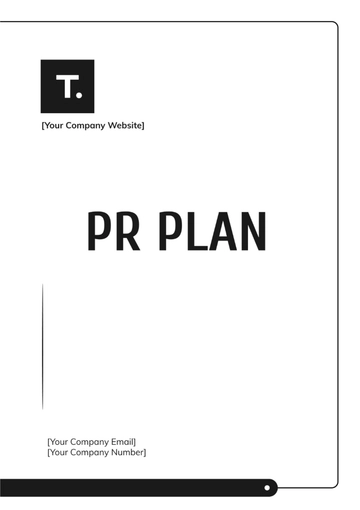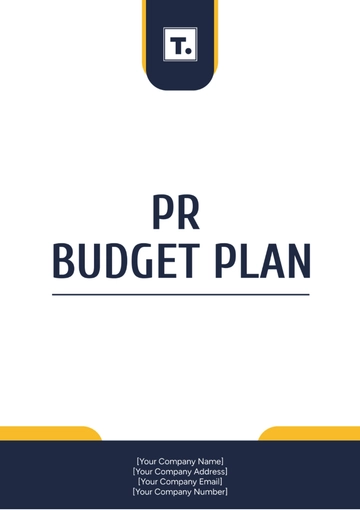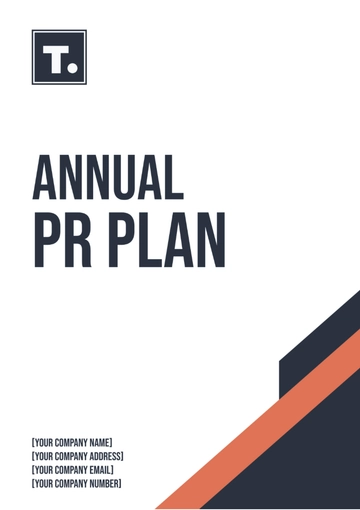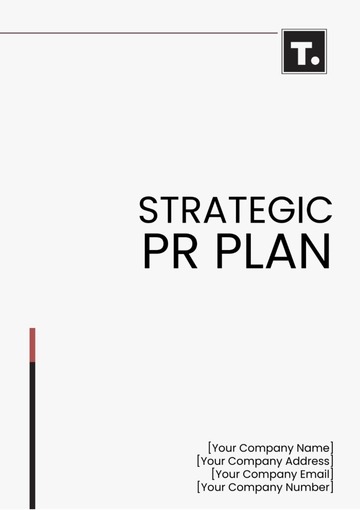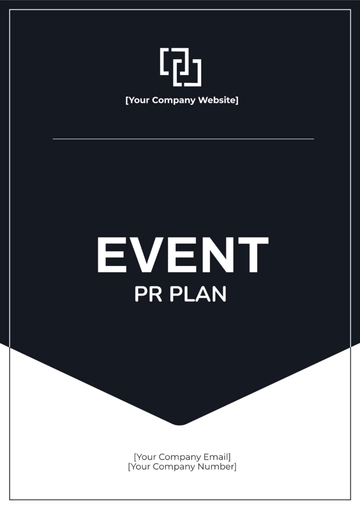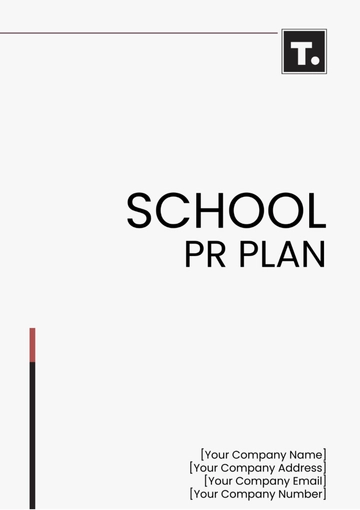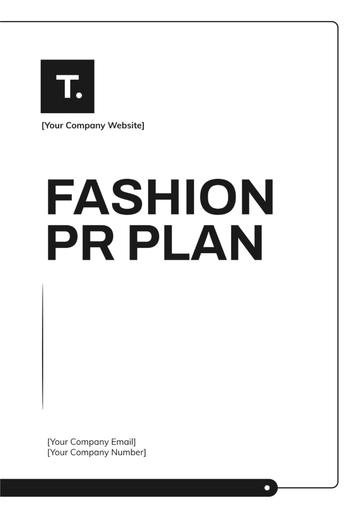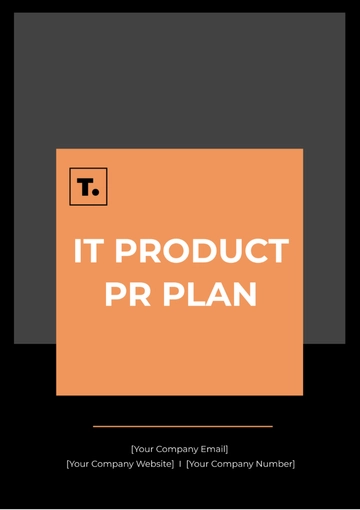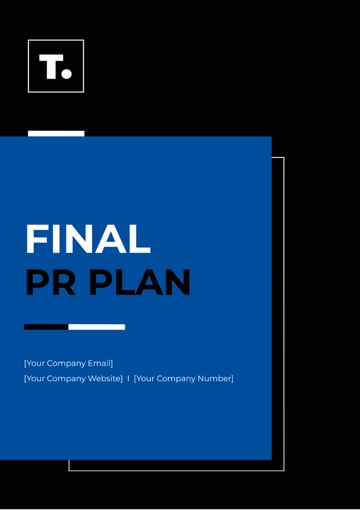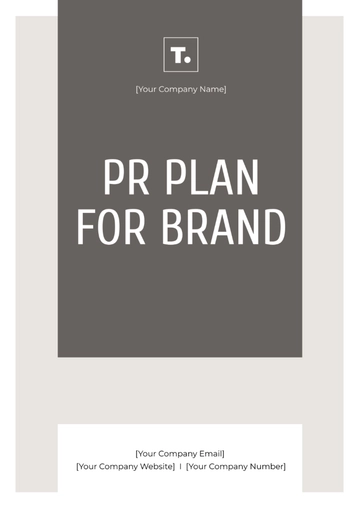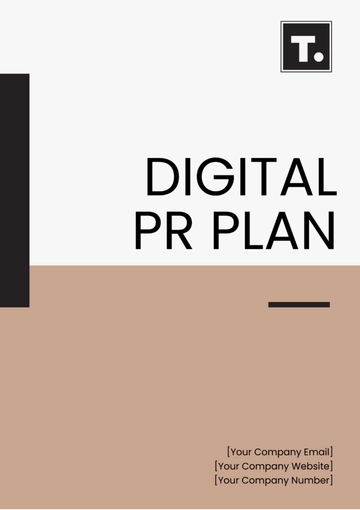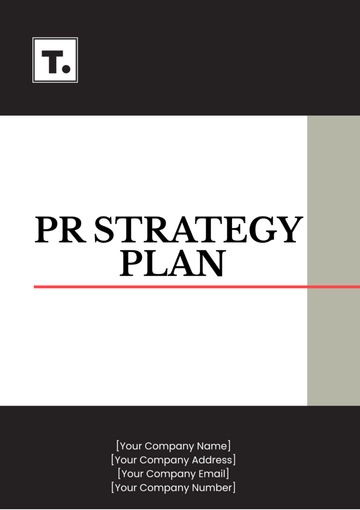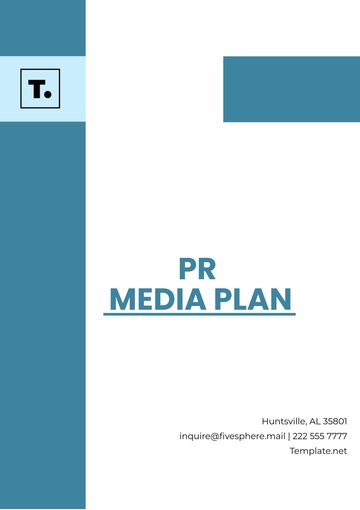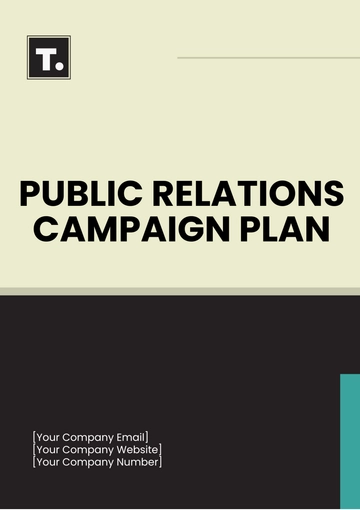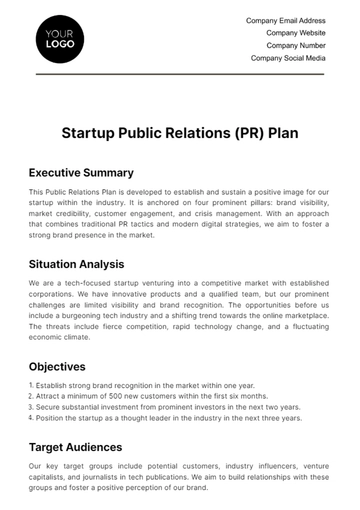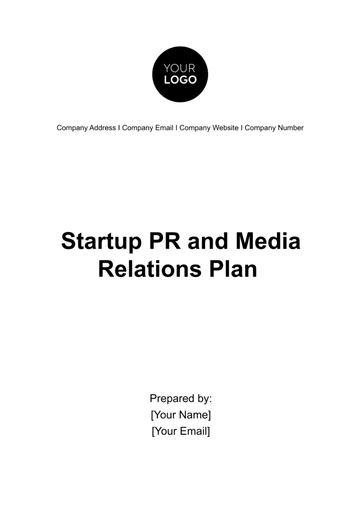Free Startup PR and Media Relations Plan
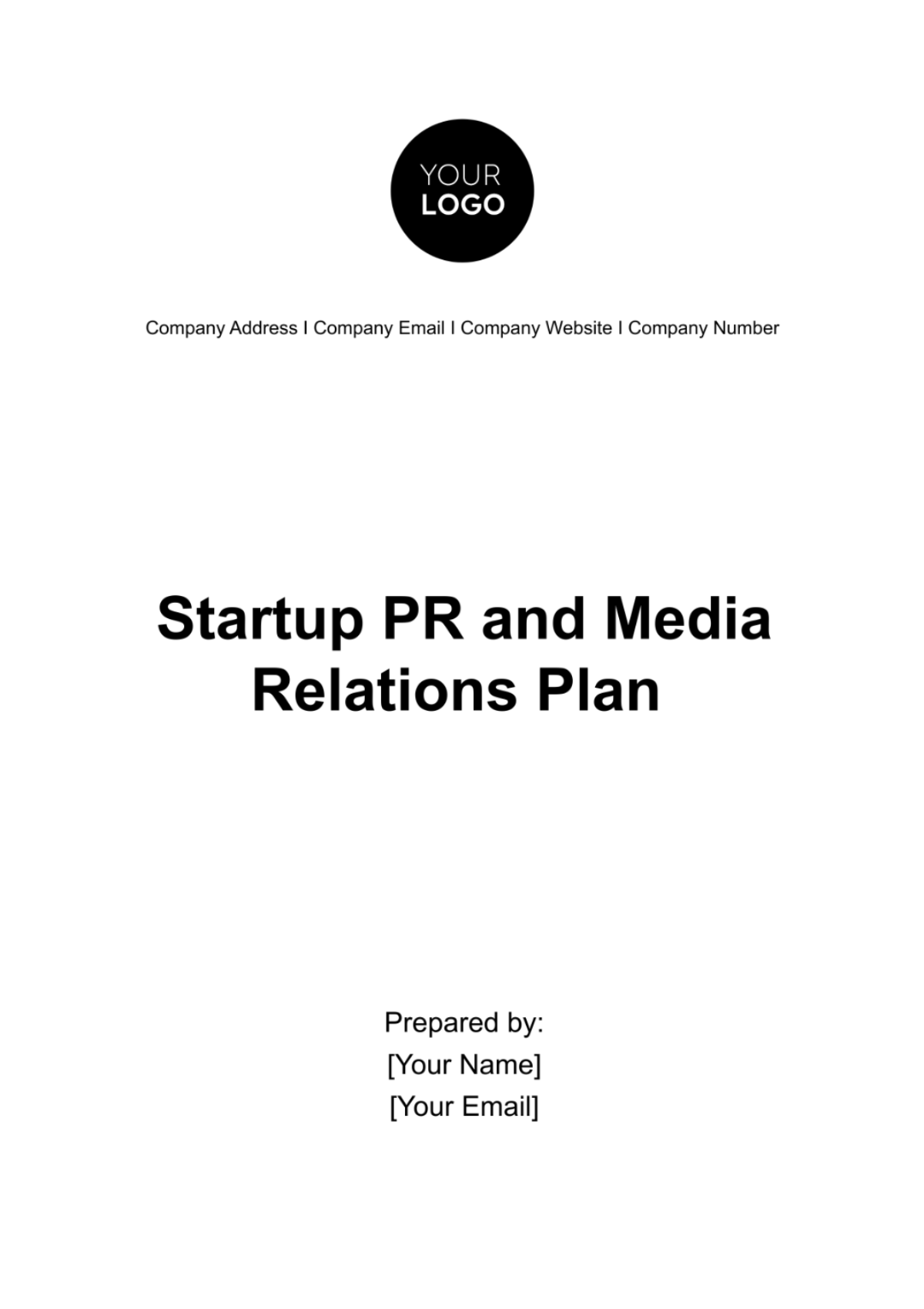
Introduction to [Your Company Name]'s PR and Media Relations Plan
In today’s fast-paced and ever-evolving market, the ability of a startup to stand out and resonate with its target audience can be the difference between success and obscurity. [Your Company Name] recognizes the indispensable role of Public Relations (PR) and Media Relations in crafting and maintaining a dynamic and engaging brand presence that not only attracts attention but fosters trust and loyalty among its audience. This document serves as a strategic blueprint designed to guide [Your Company Name] through the intricate process of establishing a solid PR foundation, engaging effectively with the media, and leveraging public relations to achieve measurable business outcomes. By adhering to the strategies and principles outlined in this plan, [Your Company Name] aims to enhance its visibility, credibility, and customer engagement, setting the stage for sustained growth and industry leadership.
Chapter 1: Understanding Your Brand
Before embarking on any external communication efforts, it is crucial for [Your Company Name] to introspect and articulate what it stands for. This involves:
Process | Details |
|---|---|
Defining Your Brand Identity | A clear brand identity encapsulates the essence of [Your Company Name], including its mission, vision, values, and the unique attributes that distinguish it from competitors. This identity serves as the core around which all PR and media relations activities revolve. |
Clarifying Your Unique Value Proposition (UVP) | The UVP succinctly communicates the benefits [Your Company Name] offers to its customers and why it is superior to alternatives. It is a statement that will be echoed in all PR messaging to reinforce the brand’s market position. |
Establishing Your Brand Voice | The brand voice reflects [Your Company Name]'s personality and how it communicates with its audience. Whether it's professional, friendly, innovative, or authoritative, maintaining a consistent voice across all communications ensures coherence and strengthens brand recognition. |
Chapter 2: Setting PR Goals for [Your Company Name]
For [Your Company Name] to navigate the competitive landscape effectively, establishing clear and strategic Public Relations (PR) goals is paramount. These goals will not only guide the PR efforts but also ensure they are aligned with the overall business objectives, contributing to the brand's growth and success.
Identifying Key Objectives
The primary aim of [Your Company Name]'s PR strategy might include enhancing brand awareness, establishing credibility within the industry, generating leads, and supporting overall marketing and sales efforts. It's crucial to break down these objectives into measurable targets, such as increasing website traffic by X%, growing social media followers by Y%, or achieving Z pieces of media coverage in key publications within a certain timeframe.
Aligning PR Goals with Overall Business Strategy
[Your Company Name]'s PR goals should directly support its broader business strategy. For instance, if the company's objective is to enter a new market or launch a new product, PR efforts could focus on creating buzz and educating potential customers about the unique value proposition of the new offering. This alignment ensures that all departments are working cohesively towards the same objectives, maximizing the impact of every initiative.
Short-term vs. Long-term Goals
Distinguishing between short-term and long-term goals allows [Your Company Name] to prioritize activities and allocate resources effectively. Short-term goals may include launching a product-specific media campaign or securing speaking engagements at industry events over the next quarter. In contrast, long-term goals could involve establishing [Your Company Name] as a thought leader in its sector or building a robust media relations network. It's important to review and adjust these goals regularly to respond to changes in the market or within the company.
Sample PR Goals for [Your Company Name]
Goal Type | Objective | Measurement Metric | Timeframe |
|---|---|---|---|
Brand Awareness | Increase brand visibility among target audience | 30% increase in website traffic | 6 months |
Credibility | Position [Your Company Name] as an industry leader | Secure 5 thought leadership articles | 1 year |
Chapter 3: Target Audience and Media Landscape
Understanding the target audience and the media landscape is pivotal for [Your Company Name] to ensure that its messages are seen and heard by the right people, through the right channels.
Segmentation of the Target Audience: Effective communication starts with knowing who you're talking to. For [Your Company Name], this means dividing the broader market into smaller, more manageable segments based on specific characteristics such as demographics, psychographics, and behavioral patterns. This process enables personalized messaging that resonates more deeply with each group, increasing the impact of your PR efforts.
Analysis of the Media Landscape: The media landscape is vast and varied, encompassing traditional outlets like newspapers and TV, digital platforms such as online publications and blogs, and social media channels. Understanding where your target audience consumes information is critical. For [Your Company Name], this might mean prioritizing industry-specific publications for B2B communications or leveraging social media influencers for B2C products. Analyzing media consumption habits helps tailor your approach to ensure maximum visibility and engagement.
Chapter 4: Crafting Your Story
The power of a well-told story cannot be underestimated in PR. [Your Company Name]'s story should encapsulate its mission, vision, and values, while highlighting its unique selling points in a way that engages and inspires.
Developing Key Messages: Identify the core messages that you want to consistently communicate across all PR channels. These should reflect [Your Company Name]'s strategic goals, such as innovation, commitment to quality, or customer-centricity, and be adaptable to different contexts and audiences.
Creating a Story that Resonates: Stories that connect on an emotional level are more likely to be remembered and shared. For [Your Company Name], this could involve sharing the founder's journey, showcasing customer success stories, or highlighting the company's impact on the community or environment. Each story should be authentic, compelling, and designed to strengthen the brand's connection with its audience.
Chapter 5: Building Media Lists
A well-curated media list is a vital tool for any PR campaign, allowing [Your Company Name] to target its outreach efforts effectively.
Strategies | Details |
|---|---|
Identifying Key Journalists and Influencers | Start by identifying journalists, bloggers, and influencers who cover your industry or topics relevant to your brand. Pay attention to their areas of interest, writing style, and audience to ensure a good fit for your story. |
Categorizing Media Contacts | Organize your media contacts into categories based on criteria such as their reach, the relevance of their audience, and their potential interest in your story. This makes it easier to tailor your pitches and increases the chances of your story being picked up. |
Best Practices for Media List Management | Keep your media list updated with contact information, areas of interest, and any interactions you've had. Building relationships with key media contacts can enhance the receptiveness to your pitches. Regularly review and refresh your list to account for changes in the media landscape, such as journalists moving to new outlets or new influencers rising to prominence. |
Chapter 6: Press Releases and Media Pitches
For [Your Company Name], crafting compelling press releases and media pitches is crucial for capturing the attention of journalists and influencers.
Writing Effective Press Releases: Press releases should concisely convey the news value of your announcement, whether it's a product launch, an event, or a significant company milestone. Start with a captivating headline, followed by a lead paragraph that summarizes the who, what, when, where, and why. Include quotes from key stakeholders for a personal touch and conclude with a boilerplate about [Your Company Name] and contact information for further inquiries.
Crafting Compelling Media Pitches: A media pitch is a personalized message sent to journalists or influencers, aiming to pique their interest in your story. It should be concise, address the recipient by name, and explain why the story is relevant to their audience. Highlight what makes your story unique and offer exclusive information or access when possible.
Timing and Distribution Strategies: Timing can significantly impact the effectiveness of your press releases and pitches. Consider the news cycle, industry events, and publication deadlines. Distribute your press release through both direct outreach to your media list and press release distribution services to maximize coverage.
Chapter 7: Media Relations Management
Building and managing relationships with the media is a continuous process that requires attention and care.
Strategies | Details |
|---|---|
Approaching and Building Relationships with Journalists | Start by engaging with journalists on social media or commenting on their articles to build rapport. When you make a pitch, personalize your communication and show that you understand their beat and audience. |
Handling Media Inquiries and Interviews | Be prompt and professional in responding to media inquiries. Prepare key messages and FAQs for interviews to ensure consistent and coherent brand representation. |
Monitoring Media Coverage | Use media monitoring tools to track mentions of [Your Company Name]. This helps you understand the reach and impact of your PR efforts and can inform future strategies. |
Chapter 8: Leveraging Digital PR
In the digital age, PR extends beyond traditional media to include online platforms and social media, offering new ways to reach and engage audiences.
Utilizing Social Media for PR Outreach: Social media platforms can amplify your PR messages and foster direct engagement with your audience. Share your press releases, media coverage, and behind-the-scenes content to build transparency and trust.
Content Marketing and Thought Leadership Strategies: Establish [Your Company Name] as an authority in its field by publishing insightful blog posts, whitepapers, and participating in industry forums. This content can attract media attention and be used as a resource for journalists.
SEO Considerations for Digital PR: Ensure your online PR materials are optimized for search engines to increase their visibility.
Chapter 9: PR Measurement and Analytics
To gauge the effectiveness of [Your Company Name]'s PR efforts, it's crucial to implement a robust measurement and analytics framework. This involves tracking a variety of metrics that reflect both the reach and the impact of your PR activities.
Defining Key Performance Indicators (KPIs): Essential KPIs for [Your Company Name] might include media coverage volume, sentiment analysis, website traffic referrals from PR sources, social media engagement rates, and conversion metrics for PR-driven leads. Each KPI should have a clear benchmark or goal for comparison.
Tools and Techniques for Measuring PR Success: Utilize tools such as Google Analytics for website traffic analysis, media monitoring services for coverage tracking, and social listening platforms to gauge public sentiment and engagement. Regularly reviewing these metrics provides insights into what's working and areas for improvement.
Analyzing Results and Adjusting Strategy: Compile your findings into regular reports for stakeholders. Use this data to refine your PR strategy, focusing more on the tactics that yield the best ROI. For instance, if feature stories in industry publications drive significant website traffic, [Your Company Name] might prioritize building relationships with journalists in this space.
Chapter 10: Crisis Management Planning
No brand is immune to potential crises, but preparation can significantly mitigate risks and impacts. Developing a crisis communication plan is crucial for [Your Company Name] to navigate unforeseen challenges effectively.
Plans | Details |
|---|---|
Preparing for Potential PR Crises | Identify potential vulnerabilities within your business that could lead to PR crises. These could range from product issues to negative customer feedback on social media. Preparing holding statements, FAQs, and response protocols in advance can expedite your response when time is critical. |
Developing a Crisis Communication Plan | This plan should outline clear procedures for internal and external communication during a crisis, including who within [Your Company Name] is responsible for communicating with the media, stakeholders, and the public. It should also specify the channels through which information will be disseminated to ensure consistent, accurate messaging. |
Training Spokespersons and Team Members | Regular training for key spokespersons and team members ensures everyone understands their role in a crisis. This includes media training for public-facing individuals to ensure they can handle press inquiries confidently and effectively. |
Conclusion: Building a Lasting Brand Through Strategic PR
The journey through [Your Company Name]'s PR and Media Relations Plan underscores the pivotal role of strategic public relations in building and maintaining a strong, dynamic brand presence. By setting clear objectives, engaging meaningfully with the media, leveraging digital platforms, measuring the impact of efforts, and preparing for potential crises, [Your Company Name] is well-positioned to achieve its PR goals and foster long-term growth.
Success in PR doesn't happen overnight. It requires persistence, adaptability, and a commitment to authentic communication. As [Your Company Name] continues to evolve, so too will its approach to PR and media relations, adapting to new challenges and seizing opportunities to tell its story. This plan is not just a roadmap but a living document that will grow with [Your Company Name], guiding its journey toward becoming a revered and trusted brand in its industry.
By staying true to its values, listening to its audience, and consistently delivering messages that resonate, [Your Company Name] can look forward to building lasting relationships with both the media and its customers. The future is bright for [Your Company Name], with strategic PR and media relations lighting the way.
- 100% Customizable, free editor
- Access 1 Million+ Templates, photo’s & graphics
- Download or share as a template
- Click and replace photos, graphics, text, backgrounds
- Resize, crop, AI write & more
- Access advanced editor
Shape your startup's public image with the Startup PR and Media Relations Plan Template from Template.net. This strategic template is customizable and editable through our Ai Editor Tool, enabling you to craft impactful communications and build strong media relationships. Elevate your visibility and credibility with targeted PR efforts, all with the support of Template.net.
You may also like
- Finance Plan
- Construction Plan
- Sales Plan
- Development Plan
- Career Plan
- Budget Plan
- HR Plan
- Education Plan
- Transition Plan
- Work Plan
- Training Plan
- Communication Plan
- Operation Plan
- Health And Safety Plan
- Strategy Plan
- Professional Development Plan
- Advertising Plan
- Risk Management Plan
- Restaurant Plan
- School Plan
- Nursing Home Patient Care Plan
- Nursing Care Plan
- Plan Event
- Startup Plan
- Social Media Plan
- Staffing Plan
- Annual Plan
- Content Plan
- Payment Plan
- Implementation Plan
- Hotel Plan
- Workout Plan
- Accounting Plan
- Campaign Plan
- Essay Plan
- 30 60 90 Day Plan
- Research Plan
- Recruitment Plan
- 90 Day Plan
- Quarterly Plan
- Emergency Plan
- 5 Year Plan
- Gym Plan
- Personal Plan
- IT and Software Plan
- Treatment Plan
- Real Estate Plan
- Law Firm Plan
- Healthcare Plan
- Improvement Plan
- Media Plan
- 5 Year Business Plan
- Learning Plan
- Marketing Campaign Plan
- Travel Agency Plan
- Cleaning Services Plan
- Interior Design Plan
- Performance Plan
- PR Plan
- Birth Plan
- Life Plan
- SEO Plan
- Disaster Recovery Plan
- Continuity Plan
- Launch Plan
- Legal Plan
- Behavior Plan
- Performance Improvement Plan
- Salon Plan
- Security Plan
- Security Management Plan
- Employee Development Plan
- Quality Plan
- Service Improvement Plan
- Growth Plan
- Incident Response Plan
- Basketball Plan
- Emergency Action Plan
- Product Launch Plan
- Spa Plan
- Employee Training Plan
- Data Analysis Plan
- Employee Action Plan
- Territory Plan
- Audit Plan
- Classroom Plan
- Activity Plan
- Parenting Plan
- Care Plan
- Project Execution Plan
- Exercise Plan
- Internship Plan
- Software Development Plan
- Continuous Improvement Plan
- Leave Plan
- 90 Day Sales Plan
- Advertising Agency Plan
- Employee Transition Plan
- Smart Action Plan
- Workplace Safety Plan
- Behavior Change Plan
- Contingency Plan
- Continuity of Operations Plan
- Health Plan
- Quality Control Plan
- Self Plan
- Sports Development Plan
- Change Management Plan
- Ecommerce Plan
- Personal Financial Plan
- Process Improvement Plan
- 30-60-90 Day Sales Plan
- Crisis Management Plan
- Engagement Plan
- Execution Plan
- Pandemic Plan
- Quality Assurance Plan
- Service Continuity Plan
- Agile Project Plan
- Fundraising Plan
- Job Transition Plan
- Asset Maintenance Plan
- Maintenance Plan
- Software Test Plan
- Staff Training and Development Plan
- 3 Year Plan
- Brand Activation Plan
- Release Plan
- Resource Plan
- Risk Mitigation Plan
- Teacher Plan
- 30 60 90 Day Plan for New Manager
- Food Safety Plan
- Food Truck Plan
- Hiring Plan
- Quality Management Plan
- Wellness Plan
- Behavior Intervention Plan
- Bonus Plan
- Investment Plan
- Maternity Leave Plan
- Pandemic Response Plan
- Succession Planning
- Coaching Plan
- Configuration Management Plan
- Remote Work Plan
- Self Care Plan
- Teaching Plan
- 100-Day Plan
- HACCP Plan
- Student Plan
- Sustainability Plan
- 30 60 90 Day Plan for Interview
- Access Plan
- Site Specific Safety Plan

